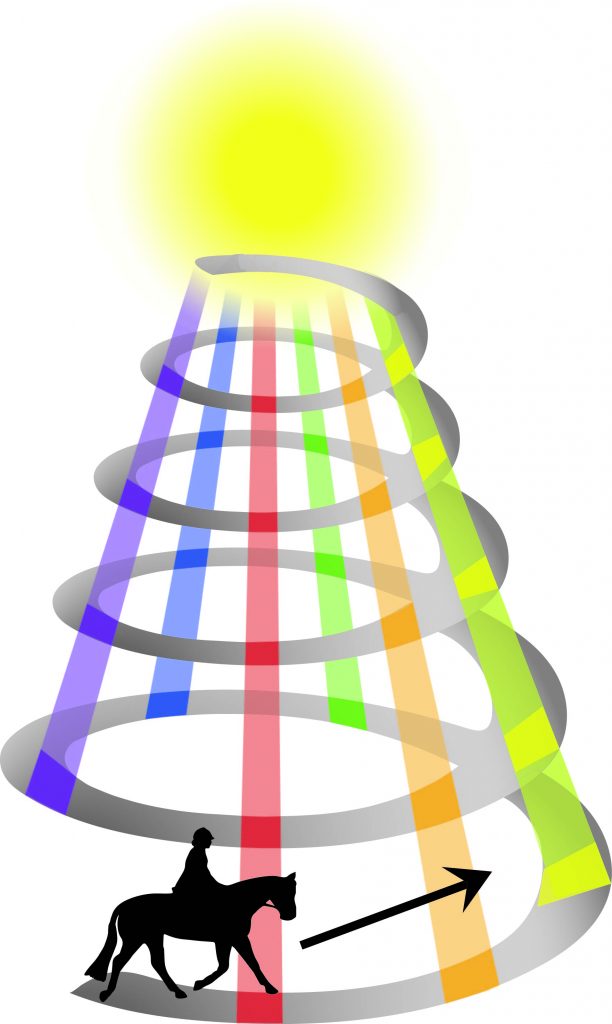
The basic idea of the Training Spiral is that you can progress through all the elements of the Scales in order (Rhythm, Suppleness, Contact, Impulsion, Straightness, Collection), without having to perfect each one before attempting the next. Instead, each element is completed to the degree that the horse can manage at his given level of training. As soon as one cycle of this training—one tier of the spiral—is completed, the next can begin—only in this new cycle (Tier 2), the degree of difficulty or quality expected is increased.
Riders of all levels and with different aims and ambitions can utilize the Training Spiral as it is applicable to anyone seeking to improve their horse’s way of going, even if they are not aiming as high as Grand Prix and even if they focus on a horse sport other than dressage. The Training Spiral can be applied over many different time frames—for example, over a five-minute section of a single training session, or over the period of a week’s training, or over the course of months of training.
As the horse’s training progresses, he moves up the tiers of the spiral, improving each of the six elements of the scales of training in the following order (Rhythm, Suppleness, Contact, Impulsion, Straightness, Collection) to an acceptable degree for the stage the horse is training at, before progressing to the next tier. There he will again work to improve each of the six elements (in order), but this time to a higher degree of quality than he did in the previous tier. This process is repeated again and again as the horse gradually improves and progresses by focusing on each of the elements of the Scales of Training, one at a time, and at an appropriate degree of difficulty for his level.
Whatever your horse’s breed and whatever your discipline, the aim should be that at each tier of the Training Spiral the six elements of the Scales become increasingly accomplished, and the horse able to perform more difficult movements and exercises while still maintaining the quality in each of the elements. Consider the horse training over a period of years. Perhaps on the first tier the horse is at Training Level—his degree of Impulsion should be enough for him to perform a forward and fluid working trot to working canter transition, and he should be able to maintain a working canter. However, the degree of Impulsion required when he is on Tier 4 of the Spiral would need to be more (when compared to the degree of Impulsion he had in Tier 1) so he can perform more challenging movements, such as transitions from walk to canter and working canter to medium canter.
An Alternative Visualization
An alternative way of visualizing this training system is to think of a Tower structure. The basic principle of the Tower is the same as the Spiral in that a sufficient degree of accomplishment should be shown in each element before moving on and adding the next element, which I picture as “adding bricks” to make a taller tower.
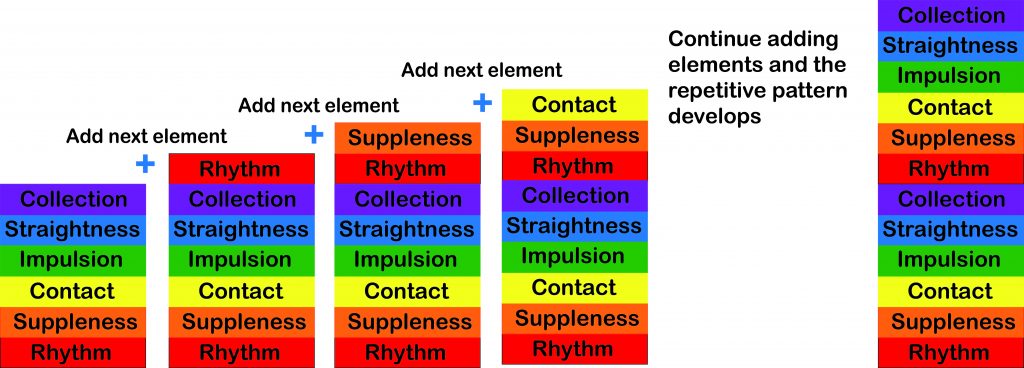
If we compare the Tower concept to the Spiral where the first tier represented the horse at Training Level, then Tier 1 of the Tower would also represent the horse’s development through Training Level where he should develop a sufficient degree of the six “bricks” (Rhythm, Suppleness, Contact, Impulsion, Straightness, and Collection) to perform all the movements required at that level. I find the two visualizations—both the Spiral and the Tower—equally useful in describing the training process.
At first glance the Tower concept may seem very similar to the traditional pyramid structure with each element “built upon” the previous elements; however, in the pyramid structure, it is generally thought that once you reach Collection, that is the end—you are at the top of the pyramid. In both the Spiral and the Tower structures, there are an infinite number of tiers. You may never reach a “top” where your horse stops confirming and improving the elements. You can always go on to spiral higher or build the Tower higher, layering on top of what you have already done. Tier 2 of the Tower is the equivalent to Tier 2 of the Spiral, but it is two tiers high and contains a total of 12 “bricks.” When you look at the degree of quality in each element in the first tier in comparison to the degree of quality in the second tier, there should be an improvement. In the first tier, the horse may be able to maintain a good Rhythm through a three-loop serpentine but loses his Rhythm when attempting a four-loop serpentine. By the second tier, he is able to maintain a good Rhythm in a four-loop serpentine. Why? Because his Suppleness, Contact, Impulsion, Straightness, and Collection all improved during the journey through the first tier!
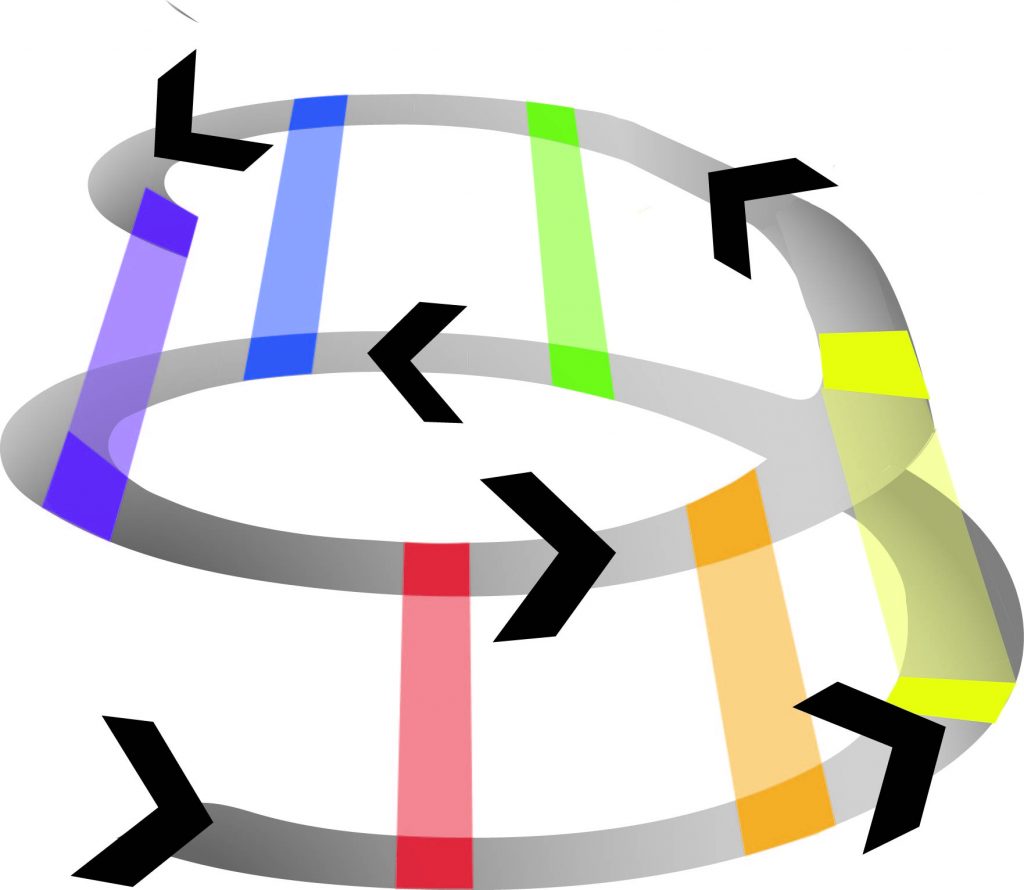
I think, partly because of the traditional pyramid structure most of us are so familiar with, people often think of Collection as something that only happens in horses that are at a very advanced stage of training. However, degrees of Collection are evident at all stages of a horse’s training. While he may not be able to perform an advanced movement, when we watch him working, we would still see a small shift in balance so he is carrying slightly more weight behind (in other words, an increased degree of Collection).
The principle of the tiers is simple and rather like playing musical scales on a piano—the pianist plays one set of notes (for example, C to B) before repeating the same sequence an octave up. Instead of starting our scales with the note C and ending on B above, we start with Rhythm and move up to Collection. When we repeat the sequence, it is with a higher degree of difficulty and quality, rather than a higher musical pitch.
Our Tower or “musical scale” can easily arrive at our Training Spiral structure—we simply take the Tower and bend it into a spiral shape.
When an Element Is Weak
When an element in a previous tier is not in place or is not working correctly, then the exercise the horse is being asked to perform in his current tier will likely fail. To illustrate the point, let’s go back to our Tower representation and imagine an example. Suppose that one of the “bricks”(in this case, let’s say it is the Impulsion brick in Tier 2) crumbles and falls apart. This means that the two “bricks” above—Straightness and Collection—are now not secure and are likely to fall from the tower. The “bricks” (or elements) below the failed Impulsion are likely to remain unaffected. In other words, the horse cannot perform the degree of Straightness and Collection being asked at Tier 2, yet is still able to perform all the qualities of the elements up to the point of weakness.
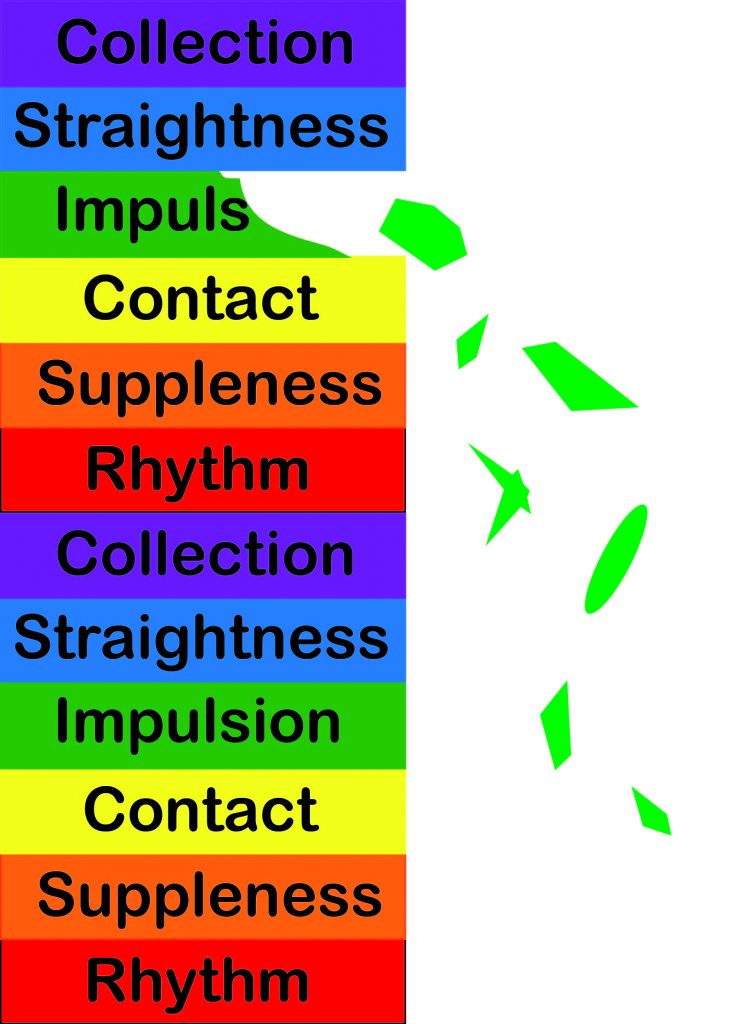
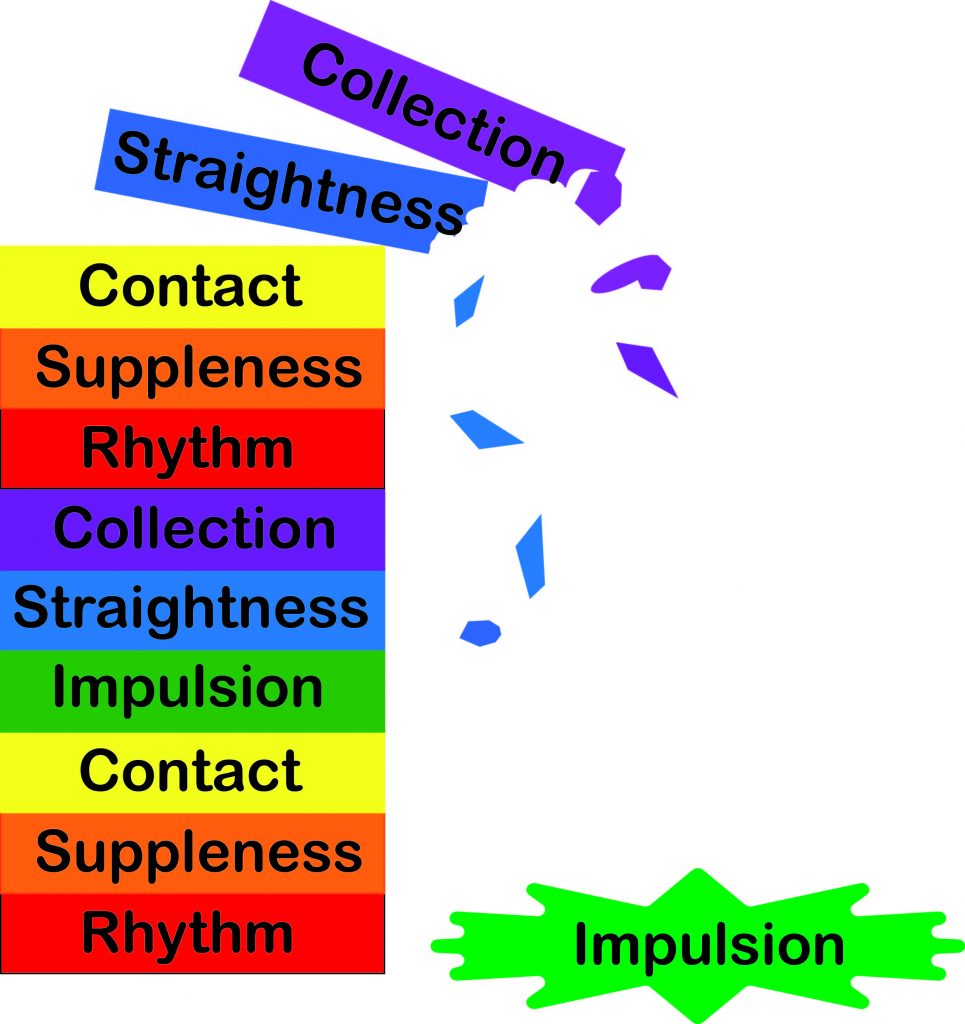
How would this look in practice with a horse at Training Level? Well, in this situation the horse may still be able to perform a lower-level movement, such as a 20-meter circle in trot, and show a good degree of quality in all the elements of the Scales of Training. The rider then moves on to ride a 10-meter circle (a more challenging movement), finds that the horse is still maintaining a good rhythm on the 10-meter circle, and the quality of the contact is okay; however, because the horse does not have enough Impulsion, his ability to “shape” (Straightness) and “carry” (Collection) his body onto the smaller curved shape required for a 10-meter circle is limited, and it is now very likely that the accuracy of the shape of the circle will not be good. If the rider moves back to the 20-meter circle again, the horse will be able to produce a good-enough quality Impulsion (and other elements) to shape and carry himself on the curve required.
This excerpt from The Training Spiral by Sue Grice is reprinted with permission from Trafalgar Square Books.










